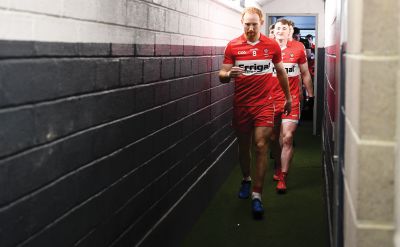HAVING watched the unbelievably exciting hurling finals on Sunday, it’s hard not to be envious of the speed and incisive transitions in those games. This is in stark contrast to the football that is currently on show.
As we enter the summer months, we are beginning to see that Gaelic football is becoming more defensive and possession based. Two high-profile examples of this were Louth and Roscommon.
Louth completely shut up shop against Mayo and dropped off to their own 45-metre line for Mayo’s kick-outs. Roscommon kept possession of the ball against Dublin for over five minutes, which is simply incredible. Now I’ll qualify this slightly by returning to my view point that I fundamentally don’t like the nature of the new group systems, i.e. Mayo had a few more gears in them and if it was a must-win game then Dublin would have aggressively taken the ball off Roscommon.
Teams are minding themselves and trying things out, in what are non-high-stakes games for the majority. For instance, watch Kerry and Dublin go through the gears this year when the games really matter. Nevertheless folks, the slow attack is the new toy.
Now when I started coaching the slow attack, the term was never heard of. However, it is now being coached up and down the country and it is highly prevalent in club training sessions.
The fundamental principle of the slow attack is that the opposition have filtered their players back, you are in possession of the ball and must create an opening by remaining patient on the ball.
We have all witnessed teams spraying the ball laterally across the pitch in an attempt to move the opposition out of their defensive structure or, even better, to draw a free. For instance, Derry did this for the first three minutes of the Ulster final and got a point. It makes for a drab affair but we have to consider the premise.
The team out of possession often have 15 players inside their own 45 and are more than happy to let the opposition have the ball outside the scoring zone. The ball carrier looks up and sees nothing but players shutting down space. The call ‘slow attack’ follows and the game of cat and mouse ensues.
The attacking team
The team in possession will go from side to side to attempt to shift defences and create an opening for a popped pass or a strike run made by a man off the shoulder. They are also looking to tempt the defensive team into fouling and giving up an almost guaranteed score.
They will often attack one corner and when the defence shuffles over to this corner, they will shift or ‘swing’ the ball in the opposite direction and probe further. The ’keeper will often join the attack as an extra threat, such as Armagh’s Ethan Rafferty.
Vitally, you must be mindful of the fact that if the move breaks down the house is down and you are dead on the counter-attack. This is where teams are coached in the arts of cynical fouling to buy time to recover.
Derry has made the first evolutionary tweak on the slow attack. They will often put four or five players right inside on the end line. This forces the opposition to drop back and mark them, thus leaving space inside the 45 to be exploited.
The defensive team
All your players are in position you now must face down the team in possession. Many teams will operate a mixture of zonal and man-to-man marking. For example, certain players will mark space but others will be allocated to mark danger men such as David Clifford for instance.
You must be careful not to be screened off by another player in this scenario and allow the danger man you are picking up a shot on the loop. Crucially, you cannot become frustrated or over-zealous and commit a silly foul. This gives managers hair like mine when this happens. You spend so much time on the training ground coaching only for a silly foul to totally kill the good work.
The final part on the defensive side really boils down to the aspirations of the team. A team that wants to frustrate and stay in the game will often only go so far. There are no issues with this if you are a perceived minnow against a giant why would you not try and be solid? The alternative is you could man up and get destroyed.
A team with ambitions of winning must see the picture in terms of counter-attacking. Yes you have players back, but you are setting up to rip the ball off the opposition and kill them with lightning transitions
Like it or not, the slow attack is now a fundamental part of our game and I believe it will become even more nuanced in the coming years. The trick is finding the balance between defensive structure and speedy transitions. This is easier said than done.
Receive quality journalism wherever you are, on any device. Keep up to date from the comfort of your own home with a digital subscription.
Any time | Any place | Anywhere












